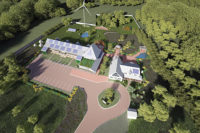Marriott International has a high standard of fire protection for its hotels and resorts.In many cases, Marriott brand standards exceed local codes and requirements.
When Marriott acquired what is now the Marriott Aspen Wye River Conference Centers, it was faced with a fire-protection dilemma.
The conference center, which sits on 1,100 acres overlooking the Wye River on Maryland’s eastern shore, did not have a fire-suppression system when the hotel giant acquired it.
“There was no fire suppression in the building,” Marriott Director of Fire Protection and Life Safety Stacy Welch, P.E., says. “It had no automatic sprinklers. It was an existing building and was not considered a high-rise, so it was in compliance with local codes.”
Marriott set out to equip the conference center with a fire-suppression system, but ran into one major roadblock.
“There is no city-supplied water available,” Welch explains. “If there was a fire event, the all-volunteer fire departments in the area would have to bring in tanker trucks or pump water from the nearby river. It was not an ideal situation.”
To solve this problem, Marriott installed a Marioff HI-FOG water mist fire-suppression system, which draws its own water from two compact on-site tanks. The tanks are stored in a basement mechanical room. Marioff is a worldwide vendor to Marriott having supplied systems in 40 properties to date.
“It was a very easy decision to make because of the challenges with the building and the location,” Welch states. “If we installed a sprinkler system, we would have needed a much larger tank that would not have fit within the footprint of the building, and that would have been a challenge because of aesthetics and needed protection for an exterior tank.”
Instead, the property’s Houghton House four-building complex is now equipped with an environmentally sustainable water mist system that uses up to 90% less water than a traditional sprinkler system. The system uses high pressure to force pure, potable water through stainless- steel tubing and specially designed sprinklers. The fine mist droplets control and suppress fire by cooling the fire itself and the air around it, blocking the radiant heat and displacing the oxygen from the seat of the fire. The droplets vaporize fast, thereby efficiently absorbing heat. The system also cuts down on sprinklerrelated damage.
“Less water is discharged into the space, so there is less water damage, which makes cleanup simpler. There is less collateral damage,” Welch says.
Installation of the system was made easier because of the use of a smaller piping footprint. “The piping size for a system such as this is much smaller than a traditional system retrofit,” Welch says. “The piping is concealed within the building. Because it was an existing building, it was an easier installation.”
Resort officials are now considering installing the system in place of a traditional sprinkler system currently installed in its four-building River House complex on the property.
“Hopefully, I’ll never see it work, but I know it will if we need it,” states Dan McKelvy, the resort’s director of engineering.
Sustainable fix
Mist fire protection system solves unique water challenge for Maryland resort.

With no city-supplied water available, the Marriott Aspen Wye River Conference Centers in Maryland was faced with a fire protection dilemma.

The resort installed a Marioff HI-FOG water mist fire suppression system in one of its buildings. The system draws its own water from two on-site tanks.

